A large wooden boat uncovered in the Sea of Galilee may provide a tangible link to one of the most famous miracles of Jesus in the Bible.
Nicknamed the ‘Jesus Boat,’ the cedar-planked vessel dates to the first century, coinciding with the era of Christ.
Biblical archaeology expert Danny Herman told the Daily Mail: ‘It’s a 2,000-year-old boat from the Sea of Galilee, the type mentioned in the Gospels, and sized for about 12 people.
‘You can actually connect it to one of the most famous stories every Christian knows, the account of Jesus walking on water and calming the storm on the lake.’
The boat was discovered in 1986 during a severe drought that exposed the Sea of Galilee’s shoreline near Magdala.
Brothers Moshe and Yuval Lufan, amateur archaeologists from Kibbutz Ginosar, spotted iron nails in the mud with a metal detector. As they dug, an oval wooden shape emerged, buried for nearly 2,000 years.
Maritime archaeologists confirmed its Roman-era construction, with carbon-14 dating placing it in the first century.
Rain returned after months of drought as the boat was uncovered, and a double rainbow appeared, an event many tied to the Gospel story of divine intervention.
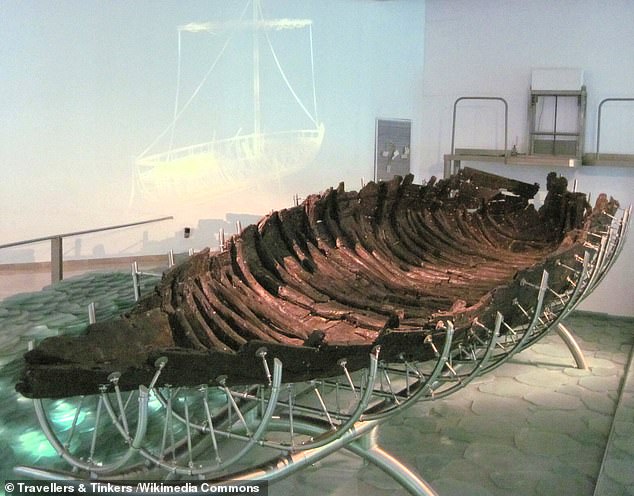
An ancient fishing boat unearthed from the depths of the Sea of Galilee in 1986 has been linked to the one in the Bible

The boat was discovered in 1986 during a severe drought that had exposed the Sea of Galilee’s shoreline near Magdala. As the excavation began, rain returned, and a striking rainbow appeared over the site
Archaeologist Dr Kurt Raveh emphasized that the probable date of construction could be traced from the first century BC to the first century AD, but you can’t ever prove that Jesus was on it or even saw it; about 600 boats were working on this lake at the time.’
The boat’s flat-bottomed design, ideal for fishing, and repairs made with cheaper local wood suggest it belonged to poor fishermen, aligning with the Gospel accounts of Jesus’ disciples.
A cooking pot and an oil lamp found nearby indicate a night journey, mirroring the Gospel narrative.
‘The oil lamp found near the boat suggests it was used for a night journey, just like the Gospel story of Jesus calming the sea,’ Herman said, noting the artifact was buried in the same silt layer as the vessel, indicating use by its occupants.
The story of Jesus walking on water, recounted in Matthew 14:22-33, Mark 6:45-52, and John 6:16-21, tells of Jesus sending his disciples across the Sea of Galilee after feeding 5,000 people.
A storm arose, and the disciples struggled against strong winds and waves. Jesus approached them, walking on the water.
Terrified, they thought he was a ghost, but Jesus said, ‘Take courage! It is I. Don’t be afraid.’ Peter stepped out to walk on the water but began to sink; Jesus caught him, saying, ‘You of little faith, why did you doubt?’
They climbed into the boat, the wind ceased, and they reached Gennesaret, near where the vessel was discovered thousands of years later.
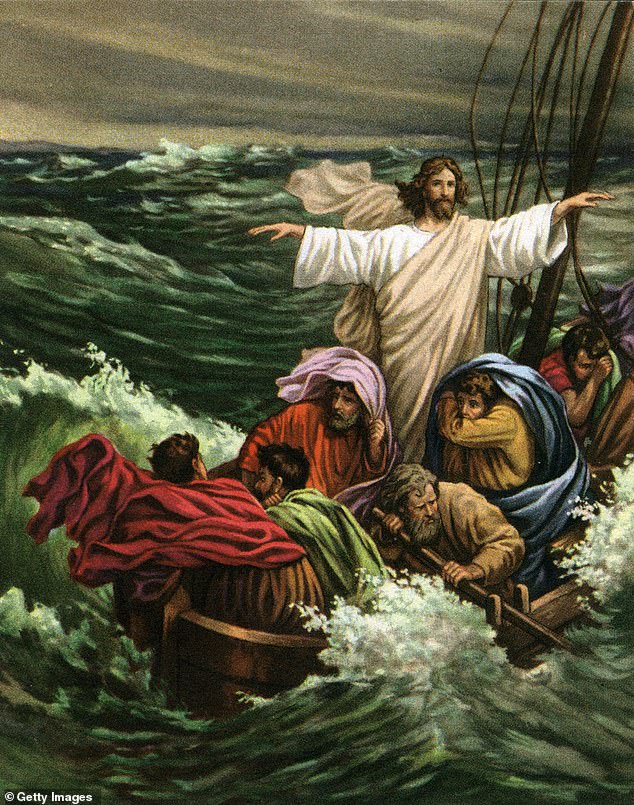
The story of Jesus walking on water and calming the sea, recounted in Matthew 14:22-33, Mark 6:45-52, and John 6:16-21, tells of Jesus sending his disciples across the Sea of Galilee after feeding the 5,000
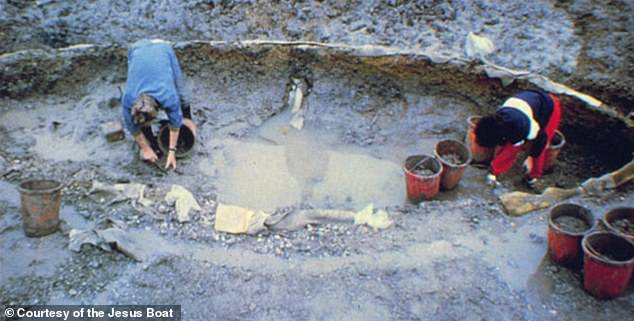
Teams worked quickly to remove the boat from the ground because the ancient wood, preserved in an anaerobic silt cocoon, crumbled when exposed to air
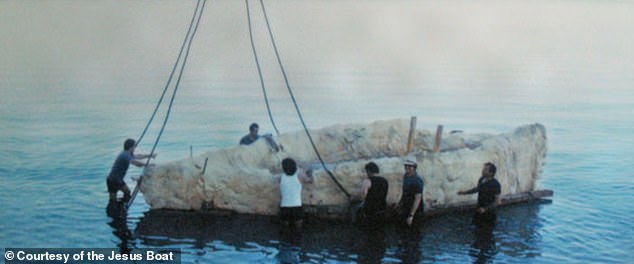
To save it, archaeologists encased it in fiberglass and insulating foam, floating it to safety before the rising waters could claim it
Herman has connected the boat to this story: ‘They landed at Gennesaret, the ancient name for Ginosar, almost exactly where the boat was found.’
The discovery was a race against time, as a two-year drought had drastically lowered the Sea of Galilee’s water levels, exposing the muddy lakebed.
As the Lufan brothers dug, the wooden boat emerged, buried for nearly 2,000 years.
Winter rains threatened to re-submerge it, so over 12 days and nights, a team from Kibbutz Ginosar, the Israel Antiquities Authority and volunteers worked tirelessly to excavate it.
The ancient wood, preserved in an anaerobic silt cocoon, crumbled when exposed to air.
To save it, archaeologists encased it in fiberglass and insulating foam, floating it to safety before the rising waters could claim it.
Archaeologist Shelley Wachsmann, who assisted with the excavation, described the effort as a ‘delicate process,’ ensuring the boat’s survival.
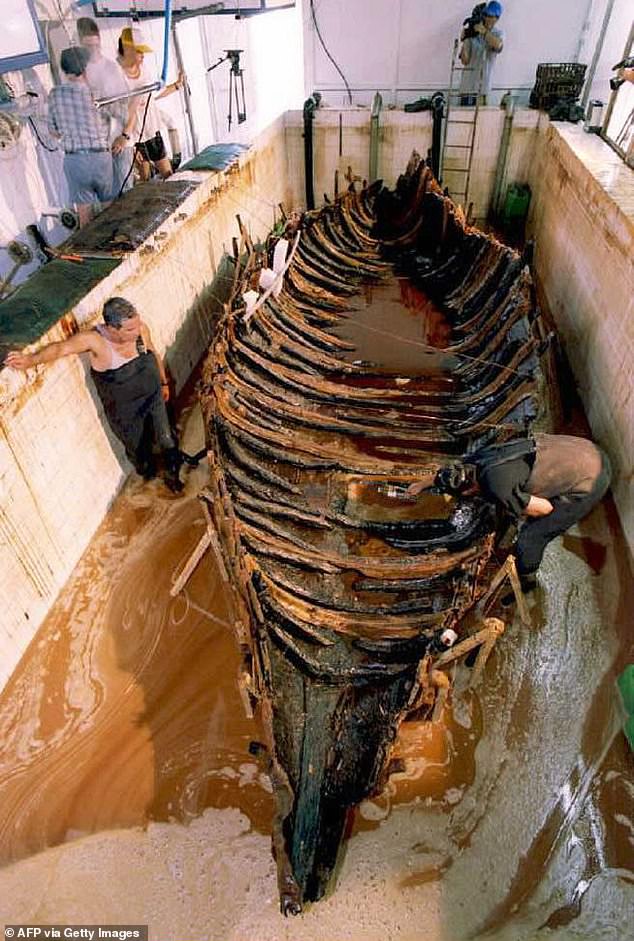
Preservation took 16 years, replacing the mud with a transparent chemical solution to prevent decay while allowing public viewing
Preservation took 16 years, replacing the mud with a transparent chemical solution to prevent decay while allowing public viewing.
Since 2000, it has been displayed at the Yigal Allon Museum in Ginosar, drawing Christian pilgrims and history enthusiasts.
Herman said, ‘It’s not just an archaeological find; it’s tied to the most famous story of Jesus on the lake. While I can’t prove it’s the boat, it’s certainly the type used in that story.’












